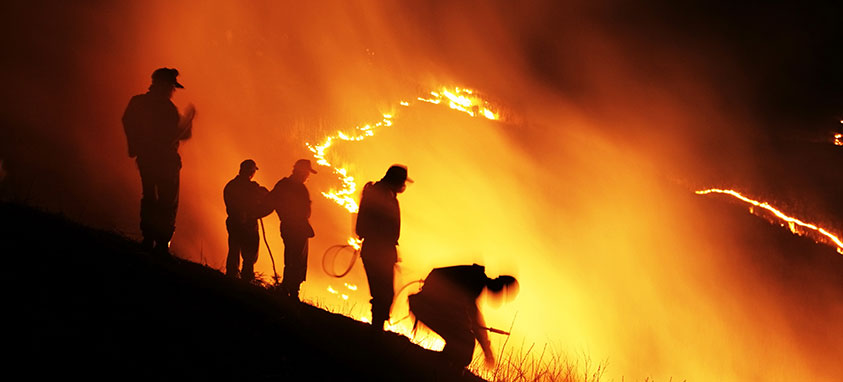Weary firefighters today battled to keep wildfires from whipping into populated (though partially evacuated) towns in Northern California’s Wine Country counties of Sonoma and Napa. Helicopters dropped water, and bulldozers continued to cut containment trenches, which now stretch around one-quarter of the two biggest fires, with a strategy of shielding cities like Napa, Calistoga and Santa Rosa.
A red-flag warning for high winds is in effect for this afternoon, an eventuality which could undo what little progress has been made to halt the horrible spread of devastation. A 30 percent chance of rain by next mid-week is being heralded as a potential savior.
The Tubbs Fire — which has burned 34,770 acres across both counties, killing 17 people — menaced about two miles outside of the now-empty vacation town of Calistoga.
Statewide, seventeen fires continue burning, turning 222,000 acres–330 square miles–to ash by Friday. Fifteen of these are in Northern California. The death toll stood at 31, and is certain to climb higher. That makes this week the deadliest for wildfires in modern state history. In burned-out areas that are accessible, search teams are now scouring charred remains with cadaver dogs, looking for bodies. Fire has destroyed an estimated 3,500 homes, businesses and commercial structures.
Overall air quality in the Bay Area was reported to be worst in the nation, and as bad as Beijing’s.
For the third straight day, passengers at San Francisco International Airport suffered delays and cancellations due to smoke from the fires, officials said. As of late morning Friday, 94 flights had been canceled, bringing the three-day total of cancellations to nearly 280, according to airport spokesman Doug Yakel.
Many of the 20,000 evacuees who fled as flames neared are still uncertain of their home’s fate, and are staying with relatives, friends or in civic centers, and other meetings and events venues throughout the Bay Area. Hotels—mostly in San Francisco—are offering special rates and accommodations for people displaced by the wildfires. Sonoma Valley Visitors Bureau has partnered with San Francisco Travel and the Hotel Council of San Francisco to free up rooms for fire victims, according to a press release.
Animal shelters and stables have offered temporary boarding for displaced pets, including horses.
The economic impact on the wine-producing region will be enormous, in tourism, wine production and lost jobs. Tourism is a multibillion-dollar industry north of San Francisco. Statewide, wineries drew 23.6 million visits and $7.2 billion in tourist expenditures, according to the Wine Institute, which ranks California as fourth-largest wine producer in the world.
So far, one hotel has been destroyed and at least a dozen wineries have been destroyed or significantly damaged. But there is fear that even where wineries emerge unscathed, the heavy smoke could infiltrate unharvested grapes and open fermentation vats and impart smoke taint, making the grapes unusable in fine wine.
Karissa Kruse, president of the Sonoma County Winegrowers, told The New York Times the repercussions of the fire on wine stored in barrels and tanks is unclear. Wineries that lost vineyards will have to nurse the soil back to health for three to five years before harvesting a viable crop of grapes, she said.
Tens of millions of dollars of marijuana, grown legally and not, will also likely be lost, consumed by flames or ruined by fires nearby. California is America’s leading domestic producer of cannabis — growing an estimated 13 million pounds per year.
“Especially when it’s ripe—I can tell you from personal experience, wildfire definitely will make your cannabis have a smoky flavor to it, just like wine,” Kristin Nevedal, executive director of the International Cannabis Farmers Association, based in the Humboldt County town of Garberville, told The San Francisco Chronicle.
Santa Rosa has emerged as the epicenter of the modern legal pot economy in California. Because the state’s cannabis industry is seeking local and state licensing under legalization Proposition 64, many companies had invested heavily in leasing and equipping warehouse space in Santa Rosa to fulfill licensing requirements. Now, with many of those warehouses gone, these investments are lost.
“Folks are out their entire life savings over the last few years to get to this point,” Hezekiah Allen, executive director of the California Growers Association, said in the Chronicle interview. “There’s no crop insurance, there’s no FEMA aid coming to our growers. It’s a pretty extreme situation out here.”




